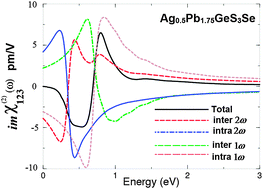Linear, non-linear optical susceptibilities and the hyperpolarizability of the mixed crystals Ag0.5Pb1.75Ge(S1−xSex)4: experiment and theory
Abstract
As the starting point for a comprehensive theoretical investigation of the linear and nonlinear optical susceptibilities, we have used our experimental crystallographic data for Ag0.5Pb1.75GeS3Se (Ag2Pb7Ge4S12Se4) reported. The experimental crystallographic positions were optimized by minimizing the forces acting on each atom to get meaningful theoretical predictions of the optical properties. The linear optical susceptibilities are calculated. We find that the optical band gap shows very good agreement with our measured gap. The second-order nonlinear optical (NLO) susceptibilities dispersion namely the optical second harmonic generation (SHG) is calculated and compared with our experimental measurements. The microscopic first order hyperpolarizability, β123, vector component along the principal dipole moment directions for the χ(2)123(ω) component was obtained theoretically and compared with our measured values at different temperatures. The dependence of the two-photon absorption (TPA) for the pump-probing at SHG of the microsecond CO2 laser was measured. In addition we explored the linear electro-optical effect in these crystals. This effect is described by the third rank polar tensors similarly to the SHG. However, for the Pockels effect besides the electronic contribution, the phonon subsystem also begins to play a principal role. As a consequence we study the dispersion of the linear electro-optical effects in the mentioned crystals.


 Please wait while we load your content...
Please wait while we load your content...